This found vintage story starts with a bottle from a patent medicine: Osgood’s India Cholagogue of Norwich, CT. The bottle is a lovely aqua color and has raised lettering and it is true vintage. Those three things are enough make it craveworthy. But you can’t look at that bottle and not wonder what on earth is a “cholagogue?”
According to the Merriam-Webster Medical Dictionary, a cholagogue is “an agent that promotes an increased flow of bile.” (Pronounced Kah-la-gog or Koal-la-gog.) That explains why advertisements for Osgood’s India Chologogue promise to cure bilious diseases. But let’s not get ahead of ourselves. More on that in a minute.
Per correspondence in the archives of the Historical Medical Library at the College of Physicians of Philadelphia, Dr. Charles Osgood introduced his India Cholagogue in 1830, including with each bottle a 16 page booklet titled The Causes, Treatment, and Cure of Fever and Ague, and other Diseases of Bilious Climates. The medication was originally made in Monroe, MI, and soon after in Norwich, CT. (Not surprisingly, these were places Dr Osgood lived, but more on that later.)
Advertisements for the medication of course made claims about its efficacy. This ad ran in the May 5, 1846 edition of Signal of Liberty an anti-slavery newspaper in Ann Arbor, MI.
But this ad in the Evansville (Indiana) Journal from July 3, 1845 is pretty committed to convincing you it works, including not one, not two, not three but four testimonials.

So what were the ingredients in Osgood’s India Chologogue? Patent medicines of the 1800s ran from the helpful to the ineffective but benign to the hair-raisingly dangerous. In The Journal of Materia Medica, Vol IV, 1862, Dr. J. A. Mayes wrote his recipe for a knockoff of Osgood’s formation. (Yes, I did look up what the ingredients on the list actually were, most are plants still used in homeopathic remedies, but since this is a found vintage post and not a doctoral dissertation, I’ll leave you to look them up yourself if you’re curious.)
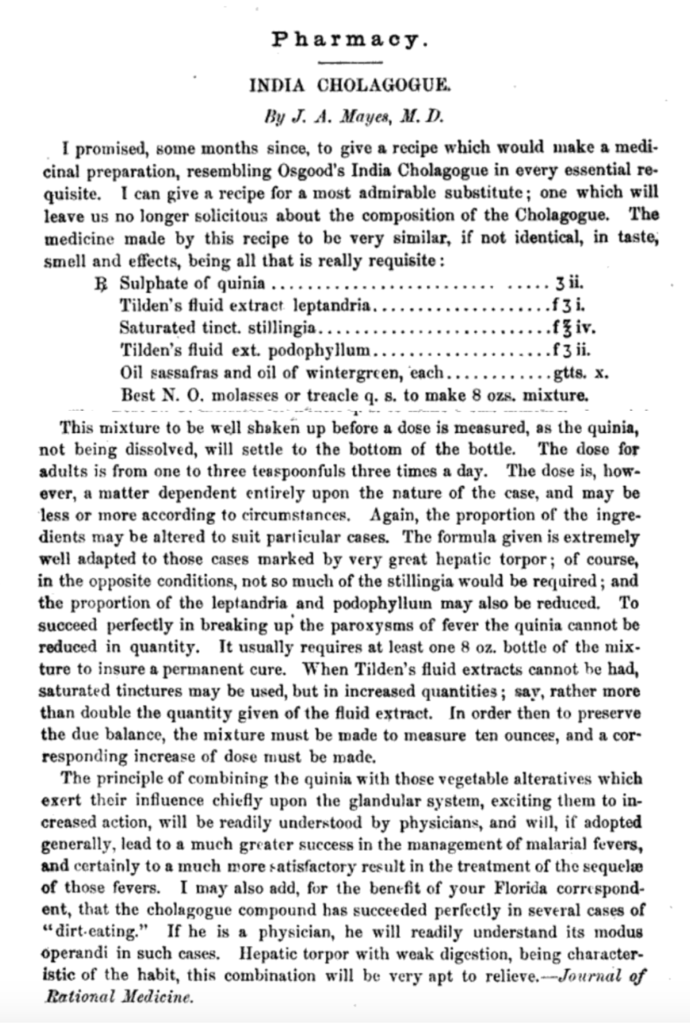
What really caught my eye was that it was helpful in resolving “dirt-eating,” and yes, according to Smithsonian Magazine, it is something people did and do for homeopathic reasons.
Jumping past the turn of the century, Fenner’s Twentieth Century Formulary and International Dispensatory: A Complete Formulary and Hand-book from 1906 has a review of Osgood’s wonder medication…
The author describes Osgood’s Indian [sic] Cholagogue as “popular and effective” but also says it was “as unsightly and nauseous a mixture as it was possible to concoct, but it was put up in good style and did its work well.” Does that mean the writer liked the bottle as much as I did? Or that it was made under relatively hygienic conditions? Or both?
So that’s the story of India Cholagogue. It would be nice to know why it’s “India” Cholagogue. Perhaps because the plants used to make it were used medicinally by Native Americans? Or it was based on a recipe from someone who travelled to India? Pure conjecture, of course, but in reading a short biography of the inventory, Dr. Charles Osgood, it seems the origin of the recipe is somewhat mysterious.
The Genealogical and Biographical Record of New London County, Connecticut (1905) gives a short chronology of Osgood’s life. He was a second generation physician, born in Lebanon, CT, in 1808. After graduating from Plainfield CT Academy, he studied medicine under his father, Dr. Erastus Osgood. He graduated from Yale Medical School in 1833 and practiced medicine in Providence, RI before relocating to Monroe, MI. It was there he “came into possession of the formula of a remedy for the cure of fever and ague which played so important a part in his subsequent commercial success.”
Came in to possession of the formula? That sounds like someone or someones else developed the cholagogue and Osgood was the one who saw its potential and acted to bring it to market. (New information on this point! Robert Beasecker, the Director of Special Collections & University Archives at Grand Valley State University in Allendale, MI posted a comment on our post. The university has acquired some of Dr. Osgood’s writings and correspondence and it would seem that Dr. Osgood was indeed the inventor of the medication.)
Osgood moved back east to Norwich, CT in 1844 and “engaged in the preparation of this remedy.” Along with the parallel development of a wholesale drug company, his India Cholagogue remedy made Dr. Osgood a very wealthy man. He was soon involved in other businesses such as banks, railroads, and the founding of the Free Academy. He served as mayor of Norwich for a short time, but resigned due to ill health, passing away in 1881. Though he was “useful in advancing public interests, active in benevolent and charitable work, and popular in society as a gentleman of superior culture and a man of the highest personal character,” if one is cynical, one still has to wonder under what terms he “came in to possession of the formula” and whether whomever he got it from was ever compensated appropriately.
All vintage has a story to tell. A pretty aqua blue bottle on a windowsill told a story of a very popular patent drug from the mid 1800s and of the man who made it, a man still remembered for his contributions to one Connecticut town. But the true origin of the recipe for Osgood’s India Chologogue remains a mystery, at least for this vintage detective.
Extra Credit:
To read more about patent medicine bottles, the Society for Historical Archaeology has a fascinating page that you can happily lose yourself in for hours.
Dr. Osgood’s wife Sarah had an elaborate bronze statue on her grave that was stolen, read about it here in The Norwich Bulletin newspaper. And read about the thief being apprehended here also in The Norwich Bulletin. Of course the thief was going to scrap it. GRRRRRR.

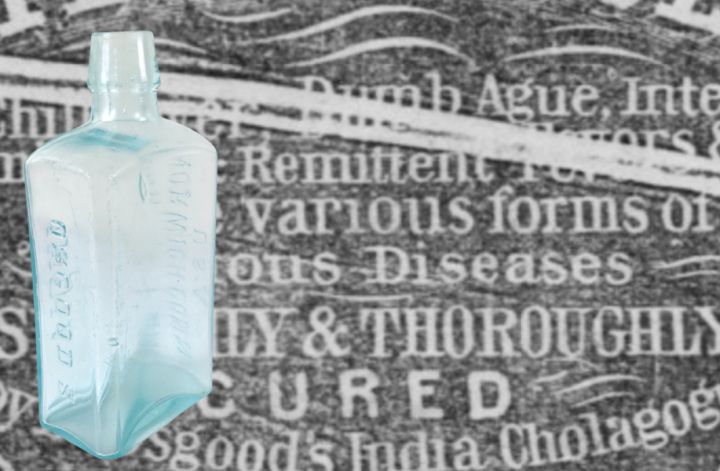
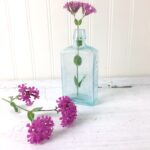
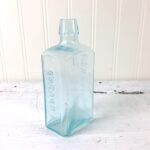

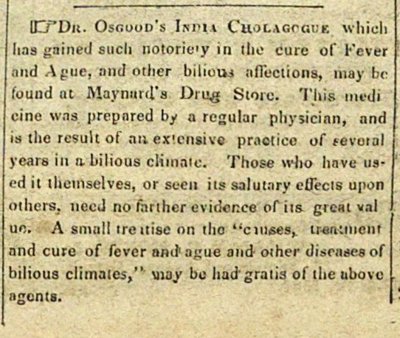

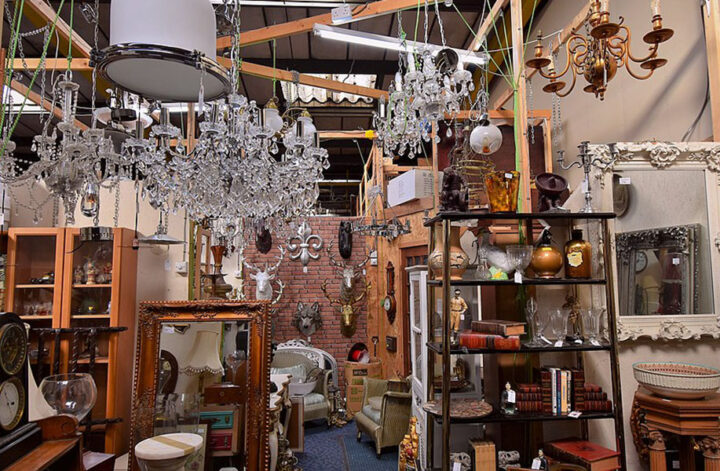


13 comments
I can add a few more details about Dr. Osgood’s remedy. We have just acquired a sizable collection of his papers and correspondence, chiefly from his time in Michigan. There is the original manuscript of his publication, “The Causes, Treatment, and Cure of Fever & Ague…” that is dated August 1840 at Monroe. He says: “The increasing demand for this remedy, its unparalleled success, and the solicitation of friends who have been restored to health by its use have induced the proprietor to present it to the public.” I take that statement to mean that he is the originator of the formula. He also describes the original container: “The India Cholagogue is prepared in octagon bottles, with the signature of Charles Osgood affixed to the seal securing the mouth of the bottle.”
Robert, Thank you so much for adding more information to our post on Dr. Osgood and his India Cholagogue. Very glad to know it was his own formula. How wonderful that you were able to add his papers and correspondence to your archives. So many vintage items pique our curiosity, but the internet can only tell us so much. We appreciate that you took the time to add to our post.
Very glad to have been able to supply further information. We’ve got one of the bottles, too; ours has straight sides and is of greenish glass. It would be a treat to find one of his original octagon bottles.
If we find one, it is headed straight to you!
I found an older bottle on eBay with the remnants of the original paper label. It is not Osgood’s hexagonal bottle, but it is an early one. I bought it for the collection, but it hasn’t as yet been received. If you’d like to see images, let me know.
I am currently writing my undergrad thesis on one of these bottles!
We’ve got two examples of the bottle in the collections. One is embossed “New York” and the other “Norwich” [Connecticut]. I believe the New York variety are the earliest made, before Osgood established his business in Norwich. If you’d like to see the original label, I can send you an image.
That would be great! thank you!!
Hello, Kellen,
I don’t think I can post an image here. If you would send me your email address, I can send you the image.
beaseckr@gvsu.edu
The item that is missing is the special secret additive- lots of dark rum. This mixture was used to help workers during the building of the Panama Canal due to illness from insects-malaria. My grandfather was a friend of the main mixer of the ‘medicine’.
Desire to own an original bottle as our family live on a property once owned by Dr. Osgood.
These show up quite often on eBay. Tougher to find one with the original label still intact, however. You’ll find two varieties: the early ones say “New York” and the later ones say “Norwich.”
My grandfather was a missionary educator, first president of the University of Shanghai. In the teens and 1920s he suffered from intermittent malaria crises. At one point, he wrote, quinine wasn’t effective and increased dose was becoming problematic. So he suggested to his fellow missionary doctor to use India or Indian Cholegogue. It worked.